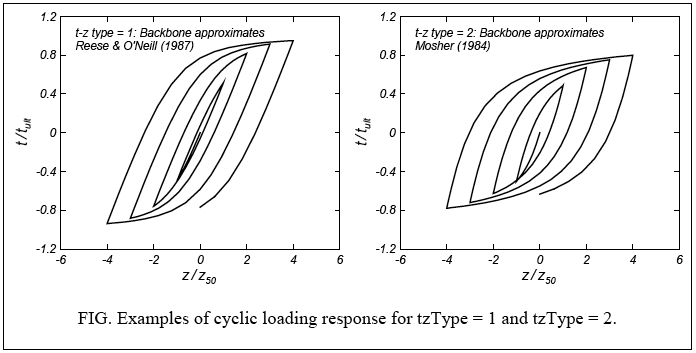QzSimple1 Material
- Command_Manual
- Tcl Commands
- Modeling_Commands
- model
- uniaxialMaterial
- ndMaterial
- frictionModel
- section
- geometricTransf
- element
- node
- sp commands
- mp commands
- timeSeries
- pattern
- mass
- block commands
- region
- rayleigh
- Analysis Commands
- Output Commands
- Misc Commands
- DataBase Commands
This command is used to construct a QzSimple1 uniaxial material object:
| uniaxialMaterial QzSimple1 $matTag $qzType $qult $Y50 <$suction $c> |
| $matTag | integer tag identifying material |
| $qzType | qzType = 1 Backbone of q-z curve approximates Reese and O'Neill's (1987) relation for drilled shafts in clay.
qzType = 2 Backbone of q-z curve approximates Vijayvergiya's (1977) relation for piles in sand. |
| $qult | Ultimate capacity of the q-z material. SEE NOTE 1. |
| $Y50 | Displacement at which 50% of qult is mobilized in monotonic loading. SEE NOTE 2. |
| $suction | Uplift resistance is equal to suction*qult. Default = 0.0. The value of suction must be 0.0 to 0.1.* |
| $c | The viscous damping term (dashpot) on the far-field (elastic) component of the displacement rate (velocity). Default = 0.0. Nonzero c values are used to represent radiation damping effects.* |
NOTES:
- $qult: Ultimate capacity of the q-z material. Note that "q" or "qult" are stresses [force per unit area of pile tip] in common design equations, but are both loads for this uniaxialMaterial [i.e., stress times tip area].
- $Y50: Displacement at which 50% of pult is mobilized in monotonic loading. Note that Vijayvergiya's relation (qzType=2) refers to a "critical" displacement (zcrit) at which qult is fully mobilized, and that the corresponding z50 would be 0. 125zcrit.
- optional args $suction and $c must either both be omitted or both provided.
THEORY:
The equations describing QzSimple1 behavior are similar to those for p-y materials by Boulanger, R. W., Curras, C. J., Kutter, B. L., Wilson, D. W., and Abghari, A. (1999). "Seismic soil-pile-structure interaction experiments and analyses." Journal of Geotechnical and Geoenvironmental Engineering, ASCE, 125(9): 750-759. Modifications were required for representing the different responses of a q-z material in compression versus uplift. The nonlinear q-z behavior is conceptualized as consisting of elastic (q-<math>z^e</math>), plastic (q-<math>z^p</math>), and gap (q-zg) components in series. Radiation damping is modeled by a dashpot on the “far-field” elastic component (q-ze) of the displacement rate. The gap component consists of a bilinear closure spring (qc-zg) in parallel with a nonlinear drag spring (qd-zg). Note that z = ze + zp + zg, and that q = qd + qc. The plastic component has an initial range of rigid behavior between -Cr qult < q < Cr qult with Cr = the ratio of q/qult when plastic yielding first occurs in virgin loading. The rigid range of q, which is initially 2 Cr qult, translates and grows with plastic yielding. The rigid range of q is constrained to a maximum size of 0.7qult. Beyond the rigid range, loading of the plastic (q-zp) component is described by:
EXAMPLE:
REFERENCES:
"Seismic Soil-pile-strcture interaction experiments and analysis", Boulanger, R.W., Curras, C.J., Kutter, B.L., Wilson, D.W., and Abghari, A. (1990). Jornal of Geotechnical and Geoenvironmental Engineering, ASCS, 125(9):750-759.
Code Developed by: Ross Boulanger, UC Davis This command is used to construct a PySimple1 uniaxial material object:
